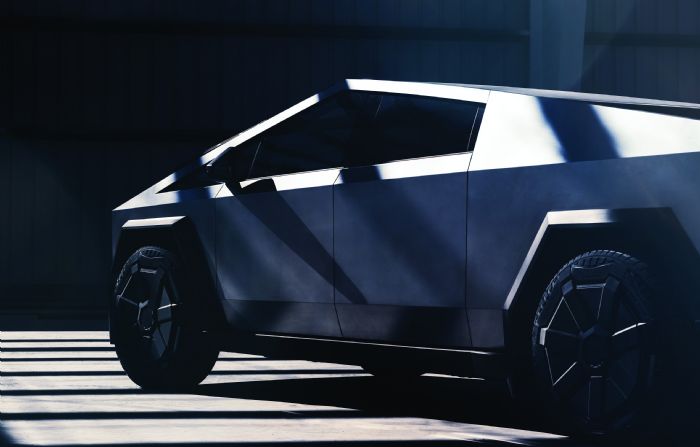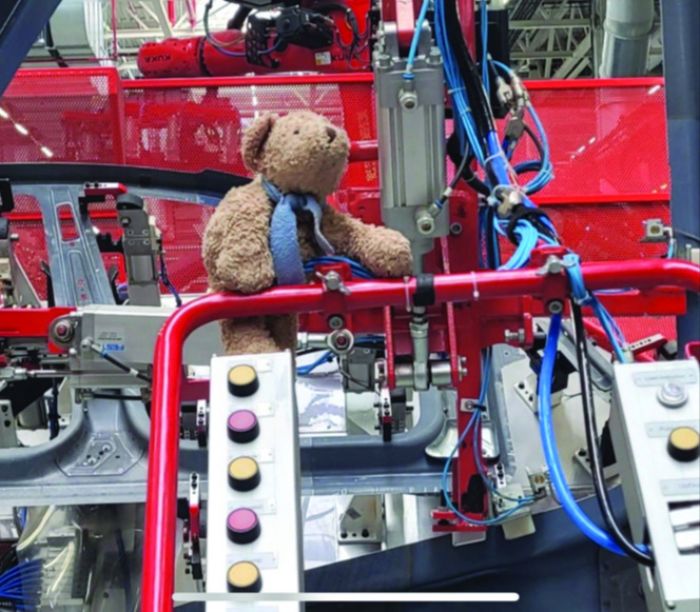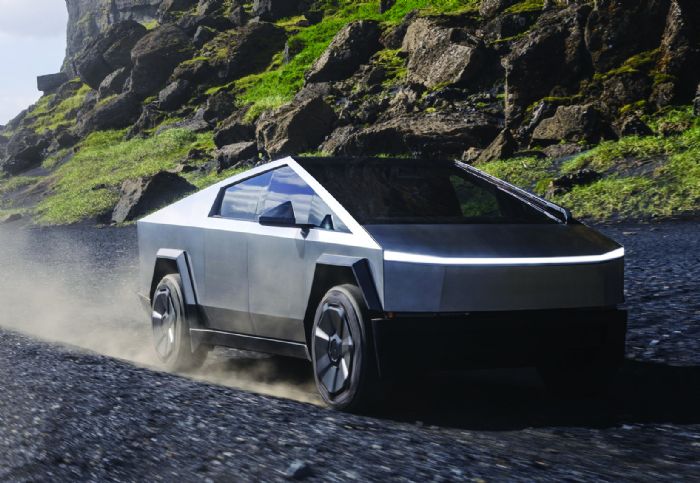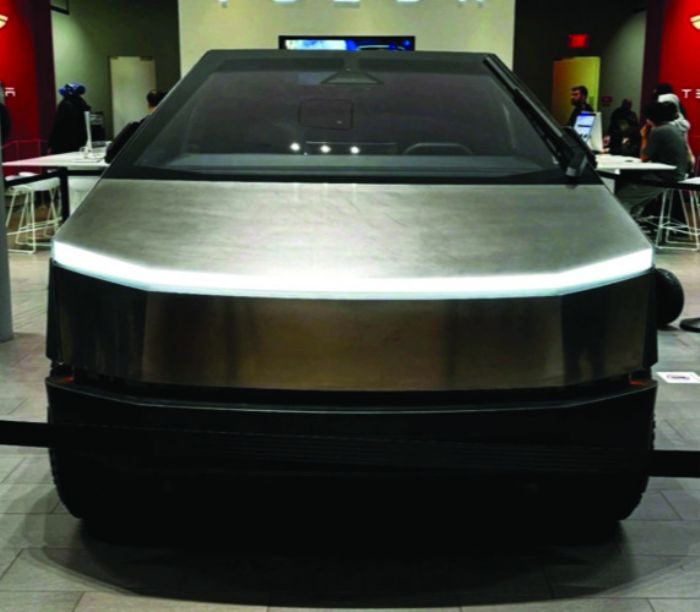2. Which parts of the Cybertruck are hot stamped?
Ausmann: Tesla hot stamped the double-door rings. That was the first hot-stamped part that Tesla had ever produced internally at any of its plants.
 3. What are some of hot stamping’s advantages over cold stamping? What are the challenges?
3. What are some of hot stamping’s advantages over cold stamping? What are the challenges?
Ausmann: The advantages not only are [making very strong parts] for safety, but having a part that’s a lot lighter in the vehicle, too, to reduce vehicle mass. Reducing weight used to be the big thing to reduce fuel consumption. Now it’s ‘How long can the battery last?’ That’s the big play. You’re heating the material to 920 to 940 C, and it’s just easier to form. But in the quenching process, there are some challenges as well.
Galling on the tooling is definitely a challenge. You’re quenching in such a rapid time. That’s very rough on the tooling. And material handling…automation’s come a long way, but still, to handle a part that’s 940 C…when you put the blank into the press to form the part, it’s so hot, it looks like an orange towel. Tooling and handling, those are some of the challenges.
 Simulations have come a long way, so those challenges are becoming less and less. There’s a lot of R&D going on and has been for quite a while now, so there are many technological advances.
Simulations have come a long way, so those challenges are becoming less and less. There’s a lot of R&D going on and has been for quite a while now, so there are many technological advances.
4. What are some hot stamping advances?
Ausmann: There are process windows that must be set to ensure that you’re still safe within the zones of what you want to produce. You can work in a larger window for faster cycle times. The problem is, if you speed something up too much during the process, you can have other issues with the integrity of the part, especially important for the crash effect.
Also, new materials. While hot aluminum stamping has been around for a little bit, it’s gaining in popularity now with electric vehicles (EVs). You don’t have to heat aluminum as much, but then it has a secondary annealing process, so it’s a longer process. Aluminum has its advantages and disadvantages. So, designers of the vehicle have another tool in their toolboxes.
Other material advances are layered materials with different thicknesses so that you don’t always have to have a thick, heavy part in the vehicle. You can optimize what the most economical part is with simulation and finite-element analysis.
Manufacturers are developing some hybrid approaches where they’re stamping the part in its martensitic state and then doing some additional forming, or different approaches to the quenching. A lot of OEMs currently use zoned hot stamping, where certain zones are purposely not hardened—they don’t want it fully hard or brittle in some areas—so a softer area helps the vehicle’s crash performance. You can do it in the tooling. There actually is a separate furnace where they adjust the temperature of that area. There’s a transition zone from the soft to the hard area. It’s a slower process.
 They may perform a combination of direct and indirect stamping, or forming the part cold and then run it through the furnace to add the final forming and quenching steps.
They may perform a combination of direct and indirect stamping, or forming the part cold and then run it through the furnace to add the final forming and quenching steps.
Tooling and dies have come a long way. The big difference between cold and hot stamping is that with hot stamping, you need a cooling/quenching mechanism. When hot stamping technology first came out, in the forming sections, the cavities were milled out; now they’re more likely to be gun-drilled, so the channels go through the tooling.
Sometimes if the part has a patch—an extra-thick section of material in an area where you need the extra support—that area might need additional cooling. You might need a cooling cavity in that area to absorb a lot more of the heat, to balance it and to increase the efficiency for a shorter cycle time.
5. What are some furnace and roller improvements?
Ausmann: The biggest difference is that you either have a chamber-type furnace—some people call it a pizza oven—with different layers; you actually can open each door separately. Or there is a longer, roller-hearth furnace that enables the part to slowly get up to speed and just go through the furnace continuously. OEMs prefer one over the other, but roller-hearth furnaces are most popular.
The rollers have come a long way, too. For example, one of the furnace companies has a cactus design. It’s a unique form; it has less contact, so less of the coating is on the material as it goes through the furnace that can contaminate the rolls. So, you have less maintenance, less cleaning, and less overall cost and downtime.
 Most materials for hot stamping—95%—are coated, so rollers with this cactus design make it a lot easier to prevent galling. That brings some other challenges. Controlling atmospheres in furnaces is very important. During the process, you don’t want to disrupt the coating, so the tooling must be modified at times to ensure that the coating remains intact.
Most materials for hot stamping—95%—are coated, so rollers with this cactus design make it a lot easier to prevent galling. That brings some other challenges. Controlling atmospheres in furnaces is very important. During the process, you don’t want to disrupt the coating, so the tooling must be modified at times to ensure that the coating remains intact.
6. How has simulation software evolved to improve hot stamping?
Ausmann: Simulation has helped advance hot stamping. Years ago, we used three different simulation-software companies. We had to make our own cards for hot stamping. So, we’d take coils of material and do testing against the grain, with the grain, 45 deg. to the grain. …Some OEMs insisted that they show you the grain direction, but the grain actually becomes uniform after the material is hot stamped. We’d then compare the simulations and approaches from the three different software companies to get best practices … go back to the actual tool—whether it was the prototype tool or the production tool—and feed that back to the simulation and fine-tune the program.
Simulation software has come a long way, with suppliers looking at friction analysis, the heating and cooling, and all that put together is a pretty complex recipe.
Simulation software saves a lot of time upfront. In the past a designer maybe was not as confident with the manufacturability, especially in the steel making. Now designers have support from the simulation. Usually the tooling or production companies give feedback as well, so they can design a part that’s feasible to make. It’s amazing how close the first hits are.
7. Have you seen changes in the presses?
Ausmann: Ultimately, the press goes up and down. Hot stamping usually uses a hydraulic press, although servo presses have shown a lot of advantages for hot stamping, to control the speeds and the press curves. With hot stamping, you need to hold the press on bottom so that you can quench the material. That’s really where the magic happens. Some parts require a very rapid closing, so you need to adjust the speeds. For part exit, you want to increase the ram speed moving upward so that the part comes out as quickly as possible. A lot of Industry 4.0 has been added to the controls of the press, so it has its own recipe for each part.
8. How has post-processing progressed?
Ausmann: In the past, post-processing included hard trimming the edges, but that was very difficult for the presses. Tooling wear was very high. Trimming was a very expensive process.
Over the years, laser cutting technology has developed for trimming hot-stamped parts. Some manufacturers feed the hot-stamped part directly into the laser for trimming, then direct feed into the subassemblies, and in some cases even direct feed into the final assembly. That process reduces floorspace and inventory…that’s a big improvement.
9. Do you see the use of hot stamping technology growing?
Ausmann: Definitely, hot stamping is a growing market, as we have seen at this conference. The percentage of vehicle content has really taken off. EV technology is pushing carmakers to come out with products that are lighter, safer and more manufacturable. It’s really taken off since it started in Sweden a few decades ago.
Other mass transportation industries now are looking at hot stamping—railways, trucking, aerospace, even bicycles. The more companies that get into hot stamping, the less investment it will take. As it becomes more of a commodity in the future, rather than specialized, we’ll see that the piece price that OEMs pay for hot-stamped parts will come down.
10. When Tesla developed its gigacasting, replacing as many as 70 stamped parts, many stampers were alarmed at the prospect of losing stamping business to castings. Now that Tesla has been able to hot stamp a very large part that formerly had been a stamped assembly, does this signal a return to stamping technology?
Ausmann: With gigacasting, Tesla really shook the market. It made everybody wonder what direction they should go in, in terms of the assembly and making assembly easier with fewer parts. It definitely makes production easier. If the volumes are there, that helps, of course. But a lot of suppliers are taking on the challenge with hot stamping as well, so that’s great to see. MF
Industry-Related Terms: Blank,
Form,
Forming,
Grain Direction,
Hydraulic Press,
LASER,
Manufacturability,
Prototype,
Quenching,
Ram,
RunView Glossary of Metalforming Terms Technologies: Management, Materials, Stamping Presses
 1. How did you happen to start working at Tesla? Tell us a little about what you’re doing there.
1. How did you happen to start working at Tesla? Tell us a little about what you’re doing there.






 3. What are some of hot stamping’s advantages over cold stamping? What are the challenges?
3. What are some of hot stamping’s advantages over cold stamping? What are the challenges? Simulations have come a long way, so those challenges are becoming less and less. There’s a lot of R&D going on and has been for quite a while now, so there are many technological advances.
Simulations have come a long way, so those challenges are becoming less and less. There’s a lot of R&D going on and has been for quite a while now, so there are many technological advances. They may perform a combination of direct and indirect stamping, or forming the part cold and then run it through the furnace to add the final forming and quenching steps.
They may perform a combination of direct and indirect stamping, or forming the part cold and then run it through the furnace to add the final forming and quenching steps.  Most materials for hot stamping—95%—are coated, so rollers with this cactus design make it a lot easier to prevent galling. That brings some other challenges. Controlling atmospheres in furnaces is very important. During the process, you don’t want to disrupt the coating, so the tooling must be modified at times to ensure that the coating remains intact.
Most materials for hot stamping—95%—are coated, so rollers with this cactus design make it a lot easier to prevent galling. That brings some other challenges. Controlling atmospheres in furnaces is very important. During the process, you don’t want to disrupt the coating, so the tooling must be modified at times to ensure that the coating remains intact.

